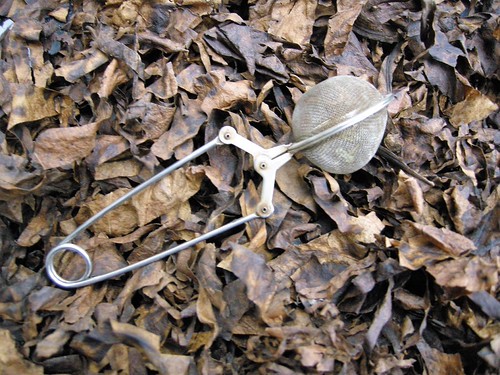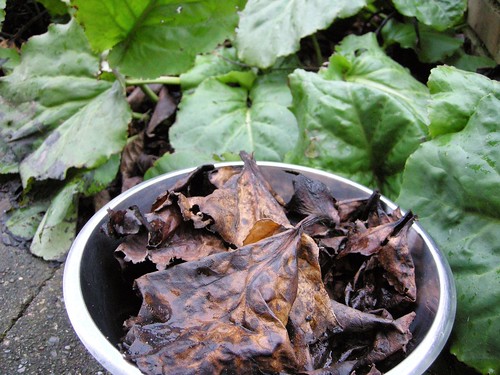 //embedr.flickr.com/assets/client-code.js
//embedr.flickr.com/assets/client-code.js
Processed Mongolian tea ready to store
Mongolian tea is naturally, on plant, fermented leaves of Bergenia crassifolia (syn. Bergenia cordifolia). It is used in Mongolia and Siberia, where Bergenia crassifolia grows in the wild. The leaves are collected when the snow melts in the spring.
 //embedr.flickr.com/assets/client-code.js
//embedr.flickr.com/assets/client-code.js
Bergenia crassifolia, flowers in may
Bergenia crassifolia is quite a common perennial in older european gardens. It is green all winter. My Bergenia crassifolia comes from my grandparents’ cottage garden. They had a large bed with it, and my mother could remember the plants from before 1930. The bed is still there – the cottage replaced with a modern comfortable house.
 //embedr.flickr.com/assets/client-code.js
//embedr.flickr.com/assets/client-code.js
The withered brown leaves harvested in winter
In Siberia and Mongolia is not unusual to drink mongolian tea. I can remember the taste. I definitely got this tea served in Siberia, thinking it was ordinary chinese black tea. Nobody told me I was wrong. The taste is gentle and pleasant.
To make your own mongolian tea, collect leaves blackened over the winter. I have noticed that in cold winters it is good to wait until the beginning of March. In mild rainy winters, I find the taste best when collecting leaves earlier, sometime in January. The crucial for harvest time decision, is how far the natural fermentation has progressed. I look into the bed from time to time during winter.
When leaves are collected, I wash off dirt, chop and dried them. They easily dry on a tray indoors. Quality is not affected by a prolonged drying time, as are so many other products for drying.
 //embedr.flickr.com/assets/client-code.js
//embedr.flickr.com/assets/client-code.js
A nice cup of mongolian tea
The mongolian tea is infused like regular black tea. However, one might consider using more tea leaves than usual, to enrich taste and colour. You can infuse the same leaves two or three times, before the taste gets insipid.
Do you want to know more, please search on “Бадан толстолистный”, and translate with Google, babel fish, etc.
Eg. I found out:
When growing, expect to harvest 3-4.5 tonnes of dried leaves per. hectare. The leaves can be harvested from the third year after planting. The area can be harvested 8-10 years or longer.
The thick rhizomes are edible, after a thorough leaching – I found no recipe.
February 4, 2016 at 20:19
Interesting reading, as I’ve recently bought seed sold as Bergenia crassifolia from an eBay seller. I had Googled it and couldn’t entirely establish if it was a synonym for B. cordifolia or not. I could have saved myself the bother and bought a plant from the garden centre! I’m glad that it is pleasant to drink, many of these ‘alternatives’ can be a bit bland or nasty. I look forward to trying it now.
February 5, 2016 at 18:14
Very interesting. I didn’t know that. I have some plants in my garden, I”ll definitely try this recipe !
February 5, 2016 at 18:33
Do try, you won’t regret !
March 11, 2016 at 07:48
I have a leaf but it’s drying very slowly. There was no dead leaf at all to collect so I took a living one. I suppose it’s a question of cold weather ; there was few hard frosts down here this winter.
March 12, 2016 at 20:00
Drying a green leaf will produce a medical tea. I guess you can make a very weak tea, to dilute all the strong tannins. Or you could try to ferment the leaf before drying.
April 2, 2016 at 20:49
Just having my first cup of mongolian bergenia tea as I write. A very pleasant drink. I first learned about this drink in the catalogue of Rühlemans Kräuter und Duftpflanzen. Snow has just melted here in southern Finland so it’s the season for withered bergenia leaves. While brewing the tea I googled for some more information and ended up here. A very interesting blog. I’m very much into permaculture and alternative crops. If only I had more time and land… Feel free to have a look at my garden at http://www.kielometsa.fi
Enjoy the growing season!
Best,
Jukka
November 14, 2016 at 17:48
Fantastic article, very interesting. Firstly, I am curious if you can use the flowers as well? And also, if I understand right, whether the steps for making a tea of this are simply: (1) Collect overwintered leaves (2) Bruise/cut/smash them and leave to dry (3) Once totally dry, use as you would black tea… ?
December 24, 2018 at 17:18
Like you I can not tell the difference in this and black tea. I do wonder what the health benefits are.
January 5, 2021 at 14:16
I’m really interested in trying this tea! I have some established bergenia plants, though I don’t know the variety (it flowers with pale pink/white flowers rather than dark pink, it came from a garden so it’s not the wild bergenia). Would any variety work for making the tea?
January 5, 2021 at 18:28
You need to identify the plant: be sure of its binominal botanical name. Bergenia cordifolia and Bergenia crassifolia are the species used in central Asia. Otherwise search google scholar for somewhat cryptic, but best knowledge of the day 🙂
January 12, 2021 at 23:56
Очин спасиbа! I saw Bergenia in Cybnpna! It is a garden plant in Ireland.
Cait
January 13, 2021 at 18:47
Пожалуйста Cait! I hope you will enjoy a nice cup of Bergenia tea.